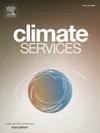利用动态季节预报开发管理驱动的阿拉斯加野火前景
IF 4
3区 环境科学与生态学
Q2 ENVIRONMENTAL SCIENCES
引用次数: 0
摘要
随着阿拉斯加及其北方森林的野火变得越来越极端,对火灾管理者来说,为即将到来的野火季节做准备变得越来越具有挑战性。这项研究是与消防管理人员密切合作开展的,以满足他们对3月和5月发布的提前夏季火灾展望的需求。三个季节预报模式用于创建夏季火情前景:NOAA CFSv2、ECMWF SEAS5和msamtsamo - france System8。来自这些预报的变量用于计算累积指数(BUI),这是一种来自加拿大森林火灾危险等级系统的实际使用的火灾天气指数。BUI的前景是基于阿拉斯加野火子季节、BUI品种和预测服务区域子区域,以及ROC曲线下面积(AUROC)、Heidke和均方误差(MSE)技能得分来评估的。技能是最伟大的风(4月1日至6月10日)和干旱(7月21日至8月9日)亚季节和阿拉斯加西部北纬亚地区。将这些模型组合成一个多模型集合,在3月(5月)预测AUROC得分时,预测技能平均提高11%(19%),在3月(5月)预测Heidke技能得分时,预测技能平均提高87%(92%)。5月的预报通常比3月的预报具有相同或更高的预报能力,在风亚季期间预报能力的提高最大。然而,3月份预报的Heidke和MSE技能得分较高的例子,特别是在后来的子季节和大火年,可以用季节性降低的可预测性来解释。在过去的30年里,阿拉斯加的野火季节发生了变化。这个季节已经延长了大约一个月,极端火灾事件变得更加频繁。消防管理人员在3月份开始为即将到来的火灾季节做准备,这比火灾季节的行政开始(4月1日)早几周,比典型的高峰(6月底至7月初)早约三个月。随着动态季节预报的可用性越来越高,阿拉斯加火灾管理界对使用这些工具进行操作规划越来越感兴趣。在这项研究中,我们使用三月初始化的季节预报来生成累积指数(BUI)的季前前景,BUI是一个关键的火灾天气变量。这些展望与火灾管理人员的关键早期决策时间一致,包括资源分配和国家协调。在提供这些展望数年之后,5月份有5位经理要求提供额外的展望,以支持在赛季开始后但在峰值之前做出的决策。虽然5月初始化的预测通常更有技巧,但我们早期对更具挑战性的3月预测的关注反映了我们对满足消防经理需求的承诺。这种长期合作,包括在春季会议上的报告和通过每两周一次的电话会议的持续参与,有助于完善我们的科学重点。通过强调焚烧垃圾的亚季节和季末降雨的时间。在整个工作过程中,我们采取了操作角度,旨在保持方法的计算效率,以适应大数据量和时间敏感的决策。因此,目前的研究使用相对简化的方法建立了预测技能的基线。这一基础使火灾管理界能够探索定制和增强预测产品的方法,例如为高纬度模型应用更先进的偏差校正技术,或按次区域或分季节改进技能评估。它还通过调整模型权重或扩展集成成员,为优化多模型集成方法创建了一个平台。这项工作是改善阿拉斯加季节性火灾天气预报的更广泛努力的一个组成部分。随着合作的继续,这些BUI展望可以与新兴的燃料和闪电的长期预测产品相结合,以建立一个更全面的即将到来的火灾季节的图景。我们仍然积极与消防经理沟通,在春季和秋季的运营会议上分享最新情况,并将他们的反馈纳入正在进行的研究和工具开发中。本文章由计算机程序翻译,如有差异,请以英文原文为准。
On using dynamical seasonal forecasts to develop management-driven wildland fire outlooks in Alaska
As wildland fires in Alaska and its boreal forest become more extreme, preparing for the upcoming wildfire season has become increasingly challenging for fire managers. This study was developed in close collaboration with fire managers to address their need for advanced summer fire outlooks issued in March and May. Three seasonal forecast models are used to create summer fire outlooks: NOAA CFSv2, ECMWF SEAS5, and Météo-France System8. Variables from these forecasts are used to calculate Buildup Index (BUI), an operationally used fire weather index from the Canadian Forest Fire Danger Rating System. The BUI outlooks are evaluated based on Alaska wildfire subseason, BUI tercile, and predictive service area subregion with the area under the ROC curve (AUROC), Heidke, and mean squared error (MSE) skill scores. Skill is greatest for the wind (April 1–June 10) and drought (July 21–August 9) subseasons and in the Western Boreal subregion of Alaska. Combining the models into a multimodel ensemble increases forecast skill by an average of 11% (19%) for the March (May) forecast AUROC score and an average of 87% (92%) for the March (May) forecast Heidke skill score. May forecasts typically have equal or greater skill than March forecasts, with the greatest increases in skill seen during the wind subseason. However, instances of higher Heidke and MSE skill scores for March forecasts, especially in later subseasons and during large fires years, could be explained by the seasonally decreased predictability.
Practical Implications
Alaska’s wildfire season has changed over the past 30 years. The season has lengthened by about a month, and extreme fire events have become more frequent. Fire managers begin preparing for the upcoming fire season in March, several weeks before the administrative start of the fire season (April 1) and about three months before the typical peak in late June to early July. With the increasing availability of dynamical seasonal forecasts, the Alaska fire management community has expressed growing interest in using these tools for operational planning.
In this study, we used March-initialized seasonal forecasts to generate early-season outlooks of the Buildup Index (BUI), a key fire weather variable. These outlooks align with the timing of critical early-season decision-making by fire managers, including resource allocation and national coordination. After several years of providing these outlooks, fire managers requested additional outlooks initialized in May to support decisions after the season has begun but before its peak. Although May-initialized forecasts are typically more skillful, our early focus on the more challenging March forecasts reflects our commitment to meeting fire managers’ needs. This long-term collaboration, including presentations at spring meetings and sustained engagement through biweekly calls, has helped refine our scientific focus—e.g., by emphasizing the duff-burning subseason and the timing of season-ending rains. Throughout this work, we have taken an operational perspective, aiming to keep methods computationally efficient to accommodate the large data volumes and time-sensitive decision-making. As such, the current study establishes a baseline of forecast skill using relatively streamlined methods. This foundation allows the fire management community to explore ways to tailor and enhance forecast products, such as applying more advanced bias correction techniques for high-latitude models or refining skill assessments by subregion or subseason. It also creates a platform for optimizing the multimodel ensemble approach, either by adjusting model weights or expanding the ensemble membership.
This work represents one component of a broader effort to improve seasonal fire weather prediction in Alaska. As collaboration continues, these BUI outlooks can be integrated with emerging long-range forecasting products for fuels and lightning to build a more comprehensive picture of the upcoming fire season. We remain actively engaged with fire managers, sharing updates during spring and fall operational meetings and incorporating their feedback in ongoing research and tool development.
求助全文
通过发布文献求助,成功后即可免费获取论文全文。
去求助
来源期刊

Climate Services
Multiple-
CiteScore
5.30
自引率
15.60%
发文量
62
期刊介绍:
The journal Climate Services publishes research with a focus on science-based and user-specific climate information underpinning climate services, ultimately to assist society to adapt to climate change. Climate Services brings science and practice closer together. The journal addresses both researchers in the field of climate service research, and stakeholders and practitioners interested in or already applying climate services. It serves as a means of communication, dialogue and exchange between researchers and stakeholders. Climate services pioneers novel research areas that directly refer to how climate information can be applied in methodologies and tools for adaptation to climate change. It publishes best practice examples, case studies as well as theories, methods and data analysis with a clear connection to climate services. The focus of the published work is often multi-disciplinary, case-specific, tailored to specific sectors and strongly application-oriented. To offer a suitable outlet for such studies, Climate Services journal introduced a new section in the research article type. The research article contains a classical scientific part as well as a section with easily understandable practical implications for policy makers and practitioners. The journal''s focus is on the use and usability of climate information for adaptation purposes underpinning climate services.
 求助内容:
求助内容: 应助结果提醒方式:
应助结果提醒方式:


